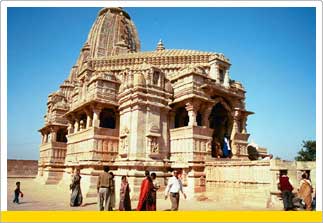| Home >> Tourist Cities in India >> Tour to Chittorgarh India | |||
| Tour to Chittorgarh India | |||

Chittorgarh, situated 112 km from Udaipur, has its legendary origins in the Mahabharata. Historically, the site was a fort and the capital of Mewar till Akbar captured it. Chittorgarh is well-known in history as the place where men and women fought valiantly to save their freedom and even gave up their lives for it. Alauddin Khilji was the first to attack Chittorgarh in 1303 AD. It is believed that he was overpowered by a desire to possess Queen Padmini. But the queen preferred death to dishonour and committed 'Jauhar'. In 1533, during the rule of Bikramjeet, Bahadur Shah attacked Chittor. Once again Jauhar was led by Rani Karanavati, a Bundi princess. Her infant son, Udai Singh was smuggled out of Chittorgarh to Bundi who survived to inherit the throne of the citadel. In 1567, when Akbar invaded Chittorgarh, Udai Singh fled to establish a new capital, Udaipur, leaving the fort to be defended by two 16-year old heroes, Jaimal of Bednore and Patta of Kelwa. Both died defending the fort which Akbar razed to the ground. Chittorgarh was never inhabited again but it always asserted the heroic spirit of Rajput warriors. The fort is in a country strewn with rocky cliffs, monsoon streams and pleasant files. The fort itself stands on a 180-metres high hill. Just 20 km away from Chittorgarh is Nagari on the banks of the river Bairach. It was known as Madhyamika and was one of the most important towns of Rajasthan in the Mauryan Empire. Excavations have revealed Hindu and Buddhist influences. There are many tourist attractions in Chittor which you must see during your India tours and travel. There is the Vijay Stambh (Victory Tower), an imposing 37-metre high structure with nine storeys, covered with exquisite sculputres of Hindu deities and depicting episodes from the Ramayana and Mahabharatha. The Kirti Stambh (Tower of Fame) stands 22 metres high. The tower is dedicated to Adinathji, the first of the Jain Tirthankaras and is decorated with figures of the Jain pantheon. The ruins of Rana Kumbha's palace are of historical and architectural interest. The palace had underground cellars where Rani Padmini and other women committed Jauhar. Nearby is Padmini's The temple where Meerabai worshipped Lord Krishna is built in north Indian style on a raised plinth with a conical roof and beautiful inner sanctum. An open colonnade around the sanctum has four small pavilions in each corner. Reaching Chittorgarh: The convenient railhead is Udaipur. | |||
 palace, built beside a pool. It was here that Rana Ratan Singh showed a glimpse of queen Padmini to Alauddin Khilji.
Among the temples in the fort city is the Kalika Mata Temple. Originally built as a Sun Temple in the 8th century, the temple was later converted into Kalika Mata Temple in the 14th century.
palace, built beside a pool. It was here that Rana Ratan Singh showed a glimpse of queen Padmini to Alauddin Khilji.
Among the temples in the fort city is the Kalika Mata Temple. Originally built as a Sun Temple in the 8th century, the temple was later converted into Kalika Mata Temple in the 14th century.